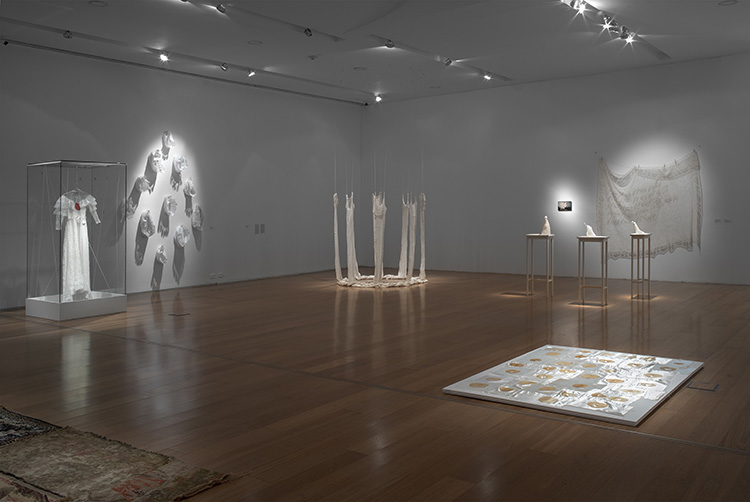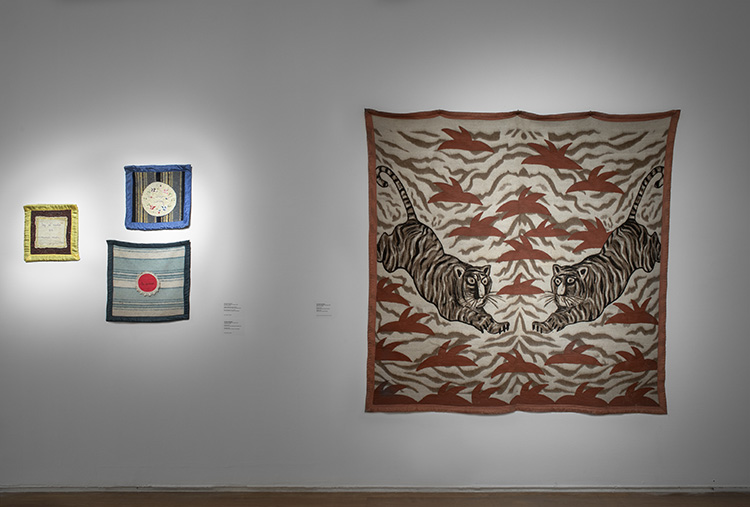
AÓ: TEXTILE EPISODES IN THE VISUAL ARTS IN PARAGUAY
In a recent essay on the power of images, Paraguayan art critic Ticio Escobar calls for other regimes of the imaginary, whether they be poetic, aesthetic, critical, or political, that “either are blended into, pass through or move autonomously from the torrents that flood the contemporary visual scene.”[1] The problem, he argues, is that contemporary critical thought is constructed on binaries, paradoxes, and antithesis. Rather than this “split basis,” it is necessary to focus on images whose efficacy arises from what Escobar calls “procedures” that reframe contradictions as filled with possibility.[2]
Escobar’s investigation of these other regimes centers on the mythical-ritual formations of the Guaraní and Ishir Indigenous peoples. Yet, it also unfolds the broader possibility of considering the impact of non-Western perspectives on image-making processes today.[3] Aó. episodios textiles de las artes visuales en el Paraguay [Aó: Textile Episodes in the Visual Arts in Paraguay] frames textile practice as a procedure that can complicate the binary systems Escobar references. Curated by Lia Colombino for the Museo de Arte Latinoamericano de Buenos Aires (MALBA), the exhibition features sixteen artworks made between 1993 and 2022 by artists whose lives and work are connected to Paraguay.[4] It presents installation and sculpture that Colombino designates as textile operations of art, which she significantly distinguishes from textile art. While the latter speaks to types of embroidery and sewing, such as ñandutí, aó po’í, poyví, and yú, prevalent in Guaraní communities, the former references practices that incorporate these textile arts within a Western conception of art making.[5]


In its title alone, the exhibition highlights how textiles populate daily life. Aó is a Guaraní word that references the many functions of fabric, be it clothing, home decoration, or blankets. At the same time, the sixteen pieces on view are not relegated to the category of either art or craft. The separation of aesthetics from function, a hallmark of Western art theory, collapses in the face of textile operations. After all, art has always had a function, whether political, economic, or religious. The exhibition clarifies that textiles are not just materials but objects that carry the historical traces of labor, culture, politics, and intimacy into the present. This is clear in Karina Yaluk’s (Misiones, Argentina, b. 1958) Y de los acontecimientos en el jardín nocturno [And About What Happened in the Nocturnal Garden] (ca. 2000), a textile collaged from silk sheets, each marked by the excrement of fish gills. Recalling a tablecloth or a bedsheet, the work reminds us that the textile objects we live with and within continue to carry indexical marks across time and space.
The tyranny of binary thinking crumbles throughout Aó. episodios textiles de las artes visuales en el Paraguay. Past and present; art and craft; ancient and contemporary; human and nonhuman; or life and death are discarded in favor of the discrete experiences that evolve in the messy, indescribable realities between such cultural constructions, developed and imposed by Western, modern, colonialist perspectives to categorize and oppress. At once ancient and contemporary, many of the textile arts on view emerged during the Conquest, and all are still practiced today.



The installation Corollas [Flower Petals] (2019) by Claudia Casarino (Asunción, Paraguay, b. 1974) unites ñandutí lace and polypropylene bags to speak to the feminine delicateness that society expects of women, even while they are forced to endure unrelenting exploitation in the workforce. The perceived fragility of the lace and flower petal contrasts with the durable polypropylene bags, symbols of industrial fabrication. Implementing a centuries-old lace-making practice to reference the current struggles women face in Paraguay, Casarino breaks down the polarities of the ancient and contemporary to initiate a visual exploration of gendered labor dynamics.
Like Casarino’s installation, Mónica Millán (San Ignacio, Misiones, Argentina, b. 1960) and Petrona Martínez’s (Yataity, Guairá, Paraguay, b. 1940) Rosa Guillermina (2010) features practices of lace-making to engage in a cross-temporal dialogue. The work comprises a hanging tablecloth made of yú lace and needlework and a small photograph of Sara López, an expert yú weaver from the Paraguayan district of Yataity del Guairá. Millán and Martínez’s tablecloth is an embroidered representation of the image of López, who stands next to her own tablecloth, Rosa Guillermina. This meta-reference to López creates a generational lineage between the three creators. At the same time, the linkage between López’s Rosa Guillermina and Millán and Martínez’s work of the same name disrupts the division between art and craft while also calling attention to the power such division holds. Why is one of these tablecloths on view in a fine arts museum and the other is not? The work invites us to interrogate the exclusionary nature that art institutions have historically implemented through categorical designations.


As the exhibition formulates, textiles and their operations also offer the possibility to question binaries beyond a humanist orientation. For those whose worldview posits human and nonhuman as distinctly antithetical entities, the climate crisis has clarified the urgency for a renewed relationship with other-than-human species. This reconstitution is based on interconnected reciprocity rather than the division that positions the nonhuman—animals, plants, and other organic matter—as a resource to be extracted. For Ao. Proyecto Herbolario [Ao. Herbalist Project] (2021), Marcos Benítez (Asunción, 1973) shrouds a tree in fabric, which picks up the grains, grooves, and other markers of bark. The resulting imprint hangs in the gallery space as monumental remnants of an endangered existence. A Veronica’s Veil for the disappearing earth, Ao. Proyecto Herbolario intimates the capture of a life soon to be lost. In his gesture of care and remembrance, Benítez enacts a challenge to the Western world’s hierarchical division of species.
Alternatively, the remnant of the human is poignantly addressed with the inclusion of three small wool blankets by the late artist Feliciano Centurión (San Ignacio de Misiones, Paraguay, 1962–Buenos Aires, 1996). On each of these surfaces, Centurión embroidered a sentimental phrase: “Soy el viento que nunca muere” [I am the wind that never dies], “te quiero” [I love you], and “corazón siempre” [forever my heart]. Created in the 1990s while the artist’s body was being ravaged by AIDS, the blankets are traces of a life that lives on through words and the sensation of touch, of a failing body wrapped for warmth. Centurión’s desire to live on in the wind defies the finality often associated with death. His blankets become specters of the artist, dissolving the supposed boundary between the living and the dead.
Contradictions, juxtapositions, binaries, and antithesis are limiting but also potential poles between which fruitful dialogues unfold. The paradoxes upon which Western colonialist culture is constructed legitimate inequality by valuing certain genders (male), races (white), backgrounds (European/North American), and species (human). Returning to Escobar, many Indigenous perspectives did and do not structure their cosmovision around the antithesis and binaries on which the modern Western world thrives. Therefore, we must ask, what does it mean that this exhibition is staged in a museum dedicated to Latin American art? This question is especially pertinent because the framework of Latin America emerged from the same colonial conditions that oppress the Indigenous labor and practice that nourish the show. Perhaps, one response rests in the procedures at play. The presentation of Aó. episodios textiles de las artes visuales en el Paraguay within a cultural-regionally-focused museum of art establishes itself as a contradiction, yet one filled with possibility.

[1] Ticio Escobar, “Ta’angá verá: The Power of Images in an Amerindian Perspective,” in Dynamis of the Image: Moving Images in a Global World, Emmanuel Alloa and Chiara Cappelletto, editors (Berlin: De Gruyter, 2020), 37.
[2] Escobar, “Ta’angá verá: The Power of Images in an Amerindian Perspective,” 38.
[3] The Guaraní are Indigenous people that live in the regions now widely referred to as Paraguay, Argentina, Brazil, Uruguay, and Bolivia. Significantly, Guaraní is one of the two official languages of Paraguay, the other being Spanish. The Ishir are Indigenous people who primarily live in the regions now widely referred to as Paraguay and Brazil.
[4] Colombino is the Director of the Museo de Arte Indígena in Asunción, Paraguay. The Museo de Arte Indígena forms part of the Centro de Artes Visuales/Museo del Barro, which Ticio Escobar organized and donated the museum’s Indigenous art collection in 1989. For further reading on Escobar and the Centro de Artes Visuales/Museo del Barro, see Karen Benezra, “Ticio Escobar: Toward a Popular Art,” Latin American and Latinx Visual Culture 4.2 (2022): 86–94.
[5] Ñandutí, which means “spider web” in Guaraní, is a type of circular embroidered lace; aó po’í is a light or thin form of embroidered cloth similar to cross-stitch or needlepoint; poyví is a handmade cotton cloth; and encaje yú is needle lace. For further reading, see Christina Turner, “Textile Art Production in Paraguay,” in Berg Encyclopedia of World Dress and Fashion, Volume 2: Latin America and the Caribbean, Margot Blum Schevill, ed. (Bloomsbury Academic, 2005): 450–52. Turner argues that while these practices are widely executed by the Guaraní, they mostly have a European rather than Indigenous heritage.
También te puede interesar
MALBA CELEBRA SU 15° ANIVERSARIO CON GRAN MUESTRA DE ARTE LATINOAMERICANO
MALBA celebra su 15° aniversario con la inauguración de Verboamérica, una nueva exposición de la colección permanente, curada por la historiadora e investigadora Andrea Giunta y por Agustín Pérez Rubio, Director Artístico del museo....
EN LA ERA COVID, CREAN RED ARGENTINA DE MUSEOS Y ESPACIOS DE ARTE
La iniciativa, liderada por la Fundación Proa, el Museo Nacional de Bellas Artes, el Museo de Arte Moderno de Buenos Aires y Malba, surge como una plataforma de cooperación interinstitucional y federal en el...
RECUERDOS IMBORRABLES: UNA MIRADA HISTÓRICA A LA COLECCIÓN VIDEOBRASIL
El descubrimiento de Brasil por los portugueses, el golpe militar en Chile, los ataques terroristas del 11 de septiembre en EEUU, la masacre de Tiananmen en China y la guerra civil en el Líbano son…



